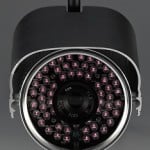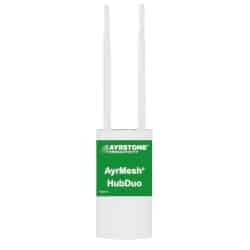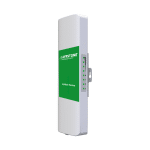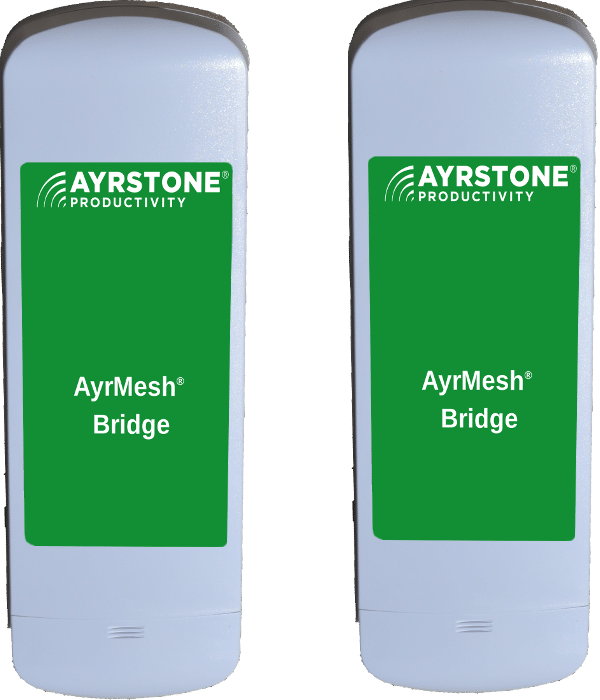
No matter where you are, everyone wants to have Internet access all the time. Whether you are working around the farm, entertaining by the pool, or just relaxing on the patio, Internet access provides information, productivity, and entertainment.
One solution for providing Internet access is adding cellular data capability to everyone’s devices. This can work, but there are two problems:
- Cellular data coverage in rural areas can be spotty. Most rural areas don’t have 4G service, and many don’t even have 3G coverage.
- Cellular data requires that each device have a cellular “modem,” which usually costs extra, and a cellular data plan, which entails a monthly fee and, in most cases, overage fees if you use large amounts of data.
But there’s now an alternative: the Ayrstone AyrMesh® system. The AyrMesh system uses high-power outdoor WiFi Access Points called AyrMesh Hubs, which mesh together using a special WiFi mode called 802.11s. AyrMesh Receivers enable non-WiFi devices to join the network, and the AyrMesh Cab Hub brings the network to your vehicles. The big difference is this: these are all high-tech devices that are designed specifically for use by people with no networking expertise. Easy to set up and use, the AyrMesh products are all designed to be installed by a farmer or homeowner, not a network technician.
Outdoor WiFi
The AyrMesh Hub is the building block of the AyrMesh network – small, lightweight, and weatherproof. The first Hub, called the “Gateway,” connects to your router and is mounted outside, up high, and in the clear for maximum range. Additional Hubs, called “Remotes” and requiring only power, extend the network across your property. Hubs can be up to 2.5 miles apart, and Remote Hubs can be “stacked” up to 3 “hops” away in every direction. Each Hub provide a normal “WiFi N” (802.11n) signal for laptops, tablets, smartphones, and other WiFi devices; Remotes also provide an Ethernet port for “wired” devices.
Complete Networking
Completing your network may entail adding wired devices in places where you don’t want to put another Hub, or bringing the network inside of buildings where outdoor WiFi won’t penetrate. For these situations, we have introduced the AyrMesh Receiver. Small, lightweight, weatherproof, and easy to mount, the AyrMesh Receiver turns the WiFi signal from the AyrMesh Hub to an Ethernet connection. One use for the AyrMesh Receiver is to add devices, like high-end IP cameras that don’t have WiFi, to your network. The other use for the AyrMesh Receiver is to bring the AyrMesh network inside of buildings, especially metal buildings that WiFi will not penetrate at all.
In some cases, you may want to place your AyrMesh Hub quite some distance from your router; we have introduced the AyrMesh Bridge to help you optimize your network. For instance, many MidWestern AyrMesh users with larger networks prefer to position their Gateway Hub at the top of their grain leg for maximum range in all directions. To do this, they connect one end of the bridge to their router and the other end of the bridge to the Gateway Hub at the top of the grain leg. The Bridge acts as a long (up to 5 miles) Ethernet cable and can be used for a variety of different purposes.
We have articles about how to plan your AyrMesh network (including when to use Hubs vs. Receivers) and how to bring your AyrMesh network into buildings.
We also have the AyrMesh IndoorHub, which attaches to any free Ethernet port (such as those on a Remote Hub, Receiver, or Bridge) to provide indoor WiFi.
The IndoorHub automatically adjusts the SSID and channel to avoid interfering with your outdoor Hubs.
The AyrMesh Hub and the AyrMesh Receiver complete the stationary part of the AyrMesh network, but living in the country is not about sitting in one place.
Security and Monitoring
Of course, the only reason to set up a network is to use it, and just being able to access the Internet from your iPad is only one use for a network. One of the most popular uses for the AyrMesh network is to use networking cameras (also known as “IP cameras”) to monitor your property, sometimes for security purposes, but frequently just for awareness: who’s parked at the equipment shed, what’s happening in the stables, etc.

Because cameras on the AyrMesh network can be viewed over the Internet (using a process called “port forwarding”), many people have installed an AyrMesh network and cameras on an aging parent’s farm to keep an eye on them from afar.
A lot of details about the use of cameras can be found on the Ayrstone Blog – this post, for instance.
Cameras are only the most popular “sensor” that can be connected to the network, but there are many others. You can connect network-enabled sensors to measure grain levels in bins, liquid levels in tanks, temperature and humidity in outbuildings, and even rainfall and windspeed in distant fields.
Communicate and Control
One of the most exciting aspects of having a farm-wide network is the opportunity to remotely or automatically control your farm – reduce the amount of “running around” on your farm. Today, there are irrigation systems, HVAC systems, and grain dryer controllers that can be controlled over the network. There will be even more devices in the future that will be able to communicate on a standard network like AyrMesh; having the network in place enables you to adopt these innovations quickly and easily.
Going Mobile
The best reason to have property is to get out and use it. Whether you are farming or ranching for profit or just enjoying your acreage, the AyrMesh Cab Hub2 can be used to extend your network to your vehicles: tractors, sprayers, and combines, of course, but also cars, trucks and ATVs.

The AyrMesh Cab Hub gives you an access point wherever your vehicle goes, as long as you are within about 2.5 miles of the nearest Hub on your network. The Cab Hub allows you to use your laptop, tablet, or smartphone on your AyrMesh WiFi network when you are far from your home, and it can also be used to automatically collect data from the precision ag hardware in your tractor, sprayer, and combine. It can even be used to feed RTK corrections from the web to your GPS steering system.
The Cab Hub is simply an AyrMesh Remote Hub that has two additional parts: a power cable that plugs into the 12 volt utility plug (or cigarette lighter) in the cab of most vehicles, and a magnetic mount antenna that goes on top of the cab of the vehicle.
The AyrMesh Cab Hub allows a single AyrMesh Hub to cover up to 12,500 contiguous acres. With additional Hubs, you can cover over 100,000.
How to get started
You must have a broadband Internet connection and a router in order to use the AyrMesh system. The easiest way to get started is to get one or more AyrMesh Hubs. The first Hub, called the Gateway, is connected to your router and then mounted outside, as high and in the clear as possible. From there you can use additional Hubs and Receivers to extend the network where you need coverage, as well as Cab Hubs to provide you mobile coverage and Bridges to optimize your network and connect distant devices and buildings.
More Information
There are pages available here with more information about the technology behind AyrMesh, the range of AyrMesh networks, and about using AyrMesh for Precision/Digital Agriculture.
If you have specific questions, please contact us.





